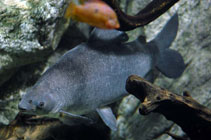| Family: |
Distichodontidae (Distichodus) |
| Max. size: |
76 cm TL (male/unsexed); max.weight: 6,250.0 g |
| Environment: |
demersal; freshwater; pH range: 6.5 - 7.5; dH range: 15, potamodromous |
| Distribution: |
Africa: from Senegal to the Chad basin (Ref. 2936, 86396), but absent in coastal basins between southern Gambia and Sassandra (Ref. 2936, 86396). Also in the Nile (Ref. 7094, 28714) and the Cross River (Ref. 81638, 86396). |
| Diagnosis: |
Dorsal spines (total): 0-0; Dorsal soft rays (total): 21-27; Anal spines: 0-0; Anal soft rays: 13-17. Diagnosis: mouth subterminal; body depth 2.7-3.6x and head length 3.3-5.5x SL; caudal peduncle 0.7-1.1x longer than wide; 12-15 scales between lateral line and scaly process at bases of pelvic fins; eye diameter 3.3 (juveniles)-7x head length; juveniles with vertical bars on sides (Ref. 2936, 86396). Round humeral spot present (less obvious in larger individuals); body never with small, dark, eye-sized spots (Ref. 81638). 83-94 lateral line scales (Ref. 2936, 81638, 86396). 21-26 (Ref. 86396) or 21-27 (Ref. 81638) total dorsal fin rays. 13-16 (Ref. 86396) or 13-17 (Ref. 81638) total anal fin rays.
Description: rounded snout (Ref. 2936, 86396). Body depth slightly proportionally deeper in larger individuals; mouth with 2 rows of bicuspid teeth in each jaw; maxilla edentulous, premaxilla with 11-12 teeth, dentary with 10-11 teeth in outer rows; ventral surface slightly convex in smaller specimens, nearly straight from vertical through insertion of pectoral fin to anal fin origin in moderate to large individuals; caudal fin lobes rounded and scales overlying rays; scales covering about ¾ of fin in smaller individuals and extending nearly to distal margin of fin in larger specimens; body scales ctenoid and small; lateral line scales to slightly beyond hypural joint and followed by smaller, sometimes irregularly pored scales; 12-15 scales between anal fin origin and lateral line (Ref. 81638). D: III-IV,18-23; A: III-IV,10-13 (Ref. 81638).
Coloration: ground color greyish, more or less dark (Ref. 2936, 86396). Preserved specimens light tan to brown; head and body darker dorsally (Ref. 81638). Upper part of dorsal fin with black lines formed by a series of points on the inter-radial membranes; juveniles with blackish, vertical, irregular cross-bars on the sides posterior of opercle to caudal peduncle (Ref. 2936, 81638, 86396). Bars become irregular and subdivided in moderately sized animals and masked in larger individuals (Ref. 81638). Black humeral spot the size of orbit in middle of anterior most vertical bar in small individuals, becoming increasingly less apparent with increasing size (Ref. 81638). Sometimes orange humeral spot (Ref. 2936, 86396). Like juveniles of Distichodus engycephalus (Ref. 2936, 86396), round dark spot present in posterior portion of caudal peduncle and mid-basal portions caudal fin in smaller individuals, spot becoming less obvious and finally absent with increasing body size; adipose, caudal and anal fins dusky (Ref. 81638). |
| Biology: |
Marco-herbivores, feed on submerged plants, Eichornia roots and periphyton (Ref. 28714). Maximum length 62.5 cm SL (Ref. 2936, 81638, 86396). |
| IUCN Red List Status: |
Least Concern (LC); Date assessed: 11 May 2019 Ref. (130435)
|
| Threat to humans: |
harmless |
Source and more info: www.fishbase.org. For personal, classroom, and other internal use only. Not for publication.

